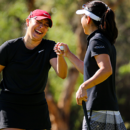Maximum Score: A New Format for a New Era

The New Rules of Golf have introduced a format called “Maximum Score.” Its definition, listed as Rule 21.2, is: “A form of stroke play where your score or your side’s score for a hole is capped at a maximum number of strokes set by the Committee, such as two times par, a fixed number or net double bogey.” This is the official lingo, but this format is something that should be considered — a formalized stopping point scorewise that is not breaking the Rules. Yes, you read that right.
We get the sense that things like this have been applied by clubs for competitions historically, but now this format can conform to the Rules of Golf. Having a maximum score defined by the Committee in charge of the competition is intended to help with pace of play. It seems so long ago that I hit four balls out of bounds and made a 13 on a hole. It took forever. Now, if playing under this format, I (as well as my group and everyone else on the course) would not have to suffer through this potential nightmare.
Rules language on this format actually includes the following: “To help pace of play, players are encouraged to stop playing a hole when their score has reached the maximum.”
The committee has quite a bit of flexibility in determining the maximum score. As noted above, it could be a fixed number or it could be something related to par, like net double bogey. I recognize that having this format available under the Rules of Golf is a real positive. The name of this column is Handicap Hints, so here are some things to know about this format and the USGA Handicap System:
1: A committee could set a maximum Equitable Stroke Control limit for handicap purposes. This would mean there would be a single maximum to consider for both the competition and for handicap score posting. (Keep this in mind as the following items are read.)
2: If a committee does implement Rule 21.2 and sets a maximum score for the competition, this does not change handicap score posting policies. What does this mean?
It means that a participant might have one score for the competition and a different score for handicap purposes. As an example, if a committee sets a maximum score of 7 on any hole for the competition, but the golfer has a Course Handicap of 25, the individual has an Equitable Stroke Control maximum of 8 for handicap purposes. If the contestant picks up after 7 strokes for the competition without holing out, the maximum score of 7 applies to the competition, but a score of 8, the Equitable Stroke Control maximum, applies for handicap score posting purposes.
3: Another item referenced in the Maximum Score Rule scoring: A player who does not hole out under the Rules for any reason gets the maximum score for the hole. We’re not sure how frequently this scenario would happen, but a player who does not hole out has different policies for handicapping, known as the most likely score. Let’s use this same golfer with a Course Handicap of 25. If for some reason that individual picked up on the green after 4 strokes, the competition score would be the maximum — 7 — but for handicap purposes the golfer would probably have a 6, under the belief that at least half the time it would only take two putts to finish the hole.
The handicap and competition scores do have the possibility of being different. That exists today in a number of situations in a variety of formats, but a committee should be aware of this in determining its maximum for the competition.
Any format that allows for the Rules of Golf to be followed and encourages improved pace of play seems like something worth trying in connection with a competition. ▪











